Exploring the Effects of MXene on Nonisothermal Crystallization and Melting Behavior of β-Nucleated Isotactic Polypropylene
Abstract
:1. Introduction
2. Experimental Section
2.1. Materials
2.2. Sample Preparation
2.2.1. Etching of MXene
2.2.2. Synthesis of β-iPP/MXene Composites
2.3. Characterization
2.3.1. X-ray Diffraction (XRD)
2.3.2. Scanning Electron Microscopy (SEM) and Energy Dispersive Spectroscopy (EDS)
2.3.3. Transmission Electron Microscope (TEM)
2.3.4. Differential Scanning Calorimetry (DSC)
2.3.5. Polarized Light Optical Microscopy (PLOM)
3. Results and Discussions
3.1. Morphology and Structure of MXene
3.2. Nonisothermal Crystallization Behavior of β-iPP/MXene Composites
3.3. Melting and Polymorphic Behavior of β-iPP/MXene Composites
3.4. Effects of Thermal Conditions
3.4.1. PLOM Observation
3.4.2. DSC Analysis
3.4.3. X-ray Diffraction (XRD)
4. Conclusions
Author Contributions
Funding
Data Availability Statement
Acknowledgments
Conflicts of Interest
References
- Natta, G.; Corradini, P. Structure and properties of isotactic polypropylene. Nuovo Cim. Suppl. 1960, 15, 40–51. [Google Scholar] [CrossRef]
- Li, Y.; Liu, H.; Huang, X.; Song, X.; Kang, J.; Chen, Z.; Zeng, F.; Chen, J. Investigation on the Roles of β-Nucleating Agents in Crystallization and Polymorphic Behavior of Isotactic Polypropylene. Polym. Sci. Ser. A 2020, 62, 470–480. [Google Scholar] [CrossRef]
- Sun, J.; Li, Q.; Yao, X.-J.; Hu, J.-S.; Qi, Y. Influence of two liquid crystalline polysiloxanes with different average molecular weight as new β-nucleator on crystallization structure of isotactic polypropylene. Polym. Bull. 2013, 70, 2519–2530. [Google Scholar] [CrossRef]
- Bruckner, S.; Meille, S.V.; Petraccone, V.; Pirozzi, B. Polymorphism in isotactic polypropylene. Prog. Polym. Sci. 1991, 16, 361–404. [Google Scholar] [CrossRef]
- Padden, F.J.; Keith, H.D. Spherulitic Crystallization in Polypropylene. J. Appl. Phys. 1959, 30, 1479–1484. [Google Scholar] [CrossRef]
- Kang, J.; Li, J.; Chen, S.; Zhu, S.; Li, H.; Cao, Y.; Yang, F.; Xiang, M. Hydrogenated petroleum resin effect on the crystallization of isotactic polypropylene. J. Appl. Polym. Sci. 2013, 130, 25–38. [Google Scholar] [CrossRef]
- Jiang, X.; Fang, Y.; Yu, Y.; Kang, J.; Cao, Y.; Xiang, M.; Li, L.; Sheng, X.; Hao, Z. Exploring the Effects of Stereo-Defect Distribution on Nonisothermal Crystallization and Melting Behavior of beta-Nucleated Isotactic Polypropylene/Graphene Oxide Composites. ACS Omega 2019, 4, 3020–3028. [Google Scholar] [CrossRef] [PubMed] [Green Version]
- Pawlak, A.; Piorkowska, E. Crystallization of isotactic polypropylene in a temperature gradient. Colloid Polym. Sci. 2001, 279, 939–946. [Google Scholar] [CrossRef]
- Zhang, B.; Chen, J.; Ji, F.; Zhang, X.; Zheng, G.; Shen, C. Effects of melt structure on shear-induced β-cylindrites of isotactic polypropylene. Polymer 2012, 53, 1791–1800. [Google Scholar] [CrossRef]
- Koscher, E.; Fulchiron, R. Influence of shear on polypropylene crystallization: Morphology development and kinetics. Polymer 2002, 43, 6931–6942. [Google Scholar] [CrossRef]
- Grein, C. Toughness of Neat, Rubber Modified and Filled β-nucleated Polypropylene: From Fundamentals to Applications. In Intrinsic Molecular Mobility and Toughness of Polymers II; Springer: Berlin/Heidelberg, Germany, 2005; pp. 43–104. [Google Scholar]
- Wang, S.-W.; Yang, W.; Bao, R.-Y.; Wang, B.; Xie, B.-H.; Yang, M.-B. The enhanced nucleating ability of carbon nanotube-supported β-nucleating agent in isotactic polypropylene. Colloid Polym. Sci. 2010, 288, 681–688. [Google Scholar] [CrossRef]
- Yu, Y.; Zeng, F.; Chen, J.; Jian, K.; Ming, X. Regulating polycrystalline behavior of the β-nucleated isotactic polypropylene/graphene oxide composites by melt memory effect. Polym. Compos. 2018, 40, E440–E448. [Google Scholar] [CrossRef]
- Yu, Y.; Xu, R.; Chen, J.; Kang, J.; Xiang, M.; Li, Y.; Li, L.; Sheng, X. Ordered structure effects on β-nucleated isotactic polypropylene/graphene oxide composites with different thermal histories. RSC Adv. 2019, 9, 19630–19640. [Google Scholar] [CrossRef] [Green Version]
- Ahmadivand, A.; Gerislioglu, B.; Ramezani, Z. Gated graphene island-enabled tunable charge transfer plasmon terahertz metamodulator. Nanoscale 2019, 11, 8091–8095. [Google Scholar] [CrossRef]
- Yadav, A.; Gerislioglu, B.; Ahmadivand, A.; Kaushik, A.; Cheng, G.J.; Ouyang, Z.; Wang, Q.; Yadav, V.S.; Mishra, Y.K.; Wu, Y.; et al. Controlled self-assembly of plasmon-based photonic nanocrystals for high performance photonic technologies. Nano Today 2021, 37. [Google Scholar] [CrossRef]
- Naguib, M.; Kurtoglu, M.; Presser, V.; Lu, J.; Niu, J.; Heon, M.; Hultman, L.; Gogotsi, Y.; Barsoum, M.W. Two-dimensional nanocrystals produced by exfoliation of Ti3AlC2. Adv. Mater. 2011, 23, 4248–4253. [Google Scholar] [CrossRef] [PubMed] [Green Version]
- Verger, L.; Natu, V.; Carey, M.; Barsoum, M.W. MXenes: An Introduction of Their Synthesis, Select Properties, and Applications. Trends Chem. 2019, 1, 656–669. [Google Scholar] [CrossRef]
- Jimmy, J.; Kandasubramanian, B. Mxene functionalized polymer composites: Synthesis and applications. Eur. Polym. J. 2020, 122. [Google Scholar] [CrossRef]
- Barsoum, M.W. MAX Phases: Properties of Machinable Ternary Carbides and Nitrides; John Wiley & Sons: Hoboken, NJ, USA, 2013. [Google Scholar]
- Zhang, H. Ultrathin Two-Dimensional Nanomaterials. Acs Nano 2015, 9, 9451–9469. [Google Scholar] [CrossRef] [PubMed]
- Verger, L.; Xu, C.; Natu, V.; Cheng, H.-M.; Ren, W.; Barsoum, M.W. Overview of the synthesis of MXenes and other ultrathin 2D transition metal carbides and nitrides. Curr. Opin. Solid State Mater. Sci. 2019, 23, 149–163. [Google Scholar] [CrossRef]
- Hu, M.; Hu, T.; Li, Z.; Yang, Y.; Cheng, R.; Yang, J.; Cui, C.; Wang, X. Surface Functional Groups and Interlayer Water Determine the Electrochemical Capacitance of Ti3C2 T x MXene. ACS Nano 2018, 12, 3578–3586. [Google Scholar] [CrossRef] [PubMed]
- Jiang, Q.; Lei, Y.; Liang, H.; Xi, K.; Alshareef, H.N. Review of MXene Electrochemical Microsupercapacitors. Energy Storage Mater. 2020, 27, 78–95. [Google Scholar] [CrossRef]
- Aslam, M.K.; Xu, M. A Mini-Review: MXene composites for sodium/potassium-ion batteries. Nanoscale 2020, 12, 15993–16007. [Google Scholar] [CrossRef] [PubMed]
- Mathis, T.S.; Maleski, K.; Goad, A.; Sarycheva, A.; Anayee, M.; Foucher, A.C.; Hantanasirisakul, K.; Shuck, C.E.; Stach, E.A.; Gogotsi, Y. Modified MAX Phase Synthesis for Environmentally Stable and Highly Conductive Ti3C2 MXene. ACS Nano 2021, 15, 6420–6429. [Google Scholar] [CrossRef]
- Garg, R.; Agarwal, A.; Agarwal, M. A review on MXene for energy storage application: Effect of interlayer distance. Mater. Res. Express 2020, 7. [Google Scholar] [CrossRef]
- Lukatskaya, M.R.; Mashtalir, O.; Ren, C.E.; Dall’Agnese, Y.; Rozier, P.; Taberna, P.L.; Naguib, M.; Simon, P.; Barsoum, M.W.; Gogotsi, Y. Cation intercalation and high volumetric capacitance of two-dimensional titanium carbide. Science 2013, 341, 1502–1505. [Google Scholar] [CrossRef] [Green Version]
- Ling, Z.; Ren, C.E.; Zhao, M.Q.; Yang, J.; Giammarco, J.M.; Qiu, J.; Barsoum, M.W.; Gogotsi, Y. Flexible and conductive MXene films and nanocomposites with high capacitance. Proc. Natl. Acad. Sci. USA 2014, 111, 16676–16681. [Google Scholar] [CrossRef] [Green Version]
- Yi, Z.; Yang, J.; Liu, X.; Mao, L.; Cui, L.; Liu, Y. Enhanced mechanical properties of poly(lactic acid) composites with ultrathin nanosheets of MXene modified by stearic acid. J. Appl. Polym. Sci. 2019, 137. [Google Scholar] [CrossRef]
- Zhang, H.; Wang, L.; Chen, Q.; Li, P.; Zhou, A.; Cao, X.; Hu, Q. Preparation, mechanical and anti-friction performance of MXene/polymer composites. Mater. Des. 2016, 92, 682–689. [Google Scholar] [CrossRef]
- Wan, Y.-J.; Li, X.-M.; Zhu, P.-L.; Sun, R.; Wong, C.-P.; Liao, W.-H. Lightweight, flexible MXene/polymer film with simultaneously excellent mechanical property and high-performance electromagnetic interference shielding. Compos. Part A Appl. Sci. Manuf. 2020, 130. [Google Scholar] [CrossRef]
- Huang, Z.; Wang, S.; Kota, S.; Pan, Q.; Barsoum, M.W.; Li, C.Y. Structure and crystallization behavior of poly(ethylene oxide)/Ti3C2Tx MXene nanocomposites. Polymer 2016, 102, 119–126. [Google Scholar] [CrossRef] [Green Version]
- Peng, W.; Hu, R.; Jiang, W.; Kang, J.; Xiang, M. Effects of MXene on Nonisothermal Crystallization Kinetics of Isotactic Polypropylene. ACS Omega 2021, 6, 19973–19982. [Google Scholar] [CrossRef]
- Kang, J.; Weng, G.; Chen, Z.; Chen, J.; Cao, Y.; Yang, F.; Xiang, M. New understanding in the influence of melt structure and β-nucleating agents on the polymorphic behavior of isotactic polypropylene. RSC Adv. 2014, 4, 29514–29526. [Google Scholar] [CrossRef]
- Luo, F.; Geng, C.; Wang, K.; Deng, H.; Chen, F.; Fu, Q.; Na, B. New Understanding in Tuning Toughness of β-Polypropylene: The Role of β-Nucleated Crystalline Morphology. Macromolecules 2009, 42, 9325–9331. [Google Scholar] [CrossRef]
- Yu, Y.; Zeng, F.; Chen, J.; Kang, J.; Yang, F.; Cao, Y.; Xiang, M. Isothermal crystallization kinetics and subsequent melting behavior of β-nucleated isotactic polypropylene/graphene oxide composites with different ordered structure. Polym. Int. 2018, 67, 1212–1220. [Google Scholar] [CrossRef]
- Yu, Y.; Jiang, X.; Fang, Y.; Chen, J.; Kang, J.; Cao, Y.; Xiang, M. Investigation on the Effect of Hyperbranched Polyester Grafted Graphene Oxide on the Crystallization Behaviors of beta-Nucleated Isotactic Polypropylene. Polymers. 2019, 11, 1988. [Google Scholar] [CrossRef] [Green Version]
- Jones, A.T.; Aizlewood, J.M.; Beckett, D.R. Crystalline Forms of Isotactic Polypropylene. Macromol. Chem. Phys. 1964, 75, 134–158. [Google Scholar] [CrossRef]
- Cao, X.; Wu, M.; Zhou, A.; Wang, Y.; He, X.; Wang, L. Non-isothermal crystallization and thermal degradation kinetics of MXene/linear low-density polyethylene nanocomposites. e-Polymers 2017, 17, 373–381. [Google Scholar] [CrossRef]
- Layachi, A.; Makhlouf, A.; Frihi, D.; Satha, H.; Belaadi, A.; Seguela, R. Non-isothermal crystallization kinetics and nucleation behavior of isotactic polypropylene composites with micro-talc. J. Therm. Anal. Calorim. 2019, 138, 1081–1095. [Google Scholar] [CrossRef]
- Avrami, M. Kinetics of Phase Change. I General Theory. J. Chem. Phys. 1939, 7, 1103–1112. [Google Scholar] [CrossRef]
- Kang, J.; Wang, B.; Peng, H.; Li, J.; Chen, J.; Gai, J.; Cao, Y.; Li, H.; Yang, F.; Xiang, M. Investigation on the dynamic crystallization and melting behavior of β-nucleated isotactic polypropylene with different stereo-defect distribution-the role of dual-selective β-nucleation agent. Polym. Adv. Technol. 2014, 25, 97–107. [Google Scholar] [CrossRef]
- Li, J.; Cheung, W.; Jia, D. A study on the heat of fusion of β-polypropylene. Polymer 1999, 40, 1219–1222. [Google Scholar] [CrossRef]
- Marco, C.; Gómez, M.A.; Ellis, G.; Arribas, J.M. Activity of a β-nucleating agent for isotactic polypropylene and its influence on polymorphic transitions. J. Appl. Polym. Sci. 2002, 86, 531–539. [Google Scholar] [CrossRef]
- Zhang, F.; Jiang, W.; Song, X.; Kang, J.; Xiang, M. Effects of Hyperbranched Polyester-Modified Carbon Nanotubes on the Crystallization Kinetics of Polylactic Acid. ACS Omega 2021, 6, 15, 10362–10370. [Google Scholar]
- Alhabeb, M.; Maleski, K.; Anasori, B.; Lelyukh, P.; Clark, L.; Sin, S.; Gogotsi, Y. Guidelines for Synthesis and Processing of Two-Dimensional Titanium Carbide (Ti3C2Tx MXene). Chem. Mater. 2017, 29, 7633–7644. [Google Scholar] [CrossRef]
- Li, C.; Zhang, X.; Wang, K.; Sun, X.; Ma, Y. Accordion-like titanium carbide (MXene) with high crystallinity as fast intercalative anode for high-rate lithium-ion capacitors. Chin. Chem. Lett. 2020, 31, 1009–1013. [Google Scholar] [CrossRef]
- Ab Alim, N.N.N.; Mohamed Saheed, M.S.; Mohamed, N.M.; Mohamed Saheed, M.S. Highly flexible and stretchable 3D graphene/MXene composite thin film. Mater. Today Proc. 2019, 7, 738–743. [Google Scholar] [CrossRef]
- Gao, J.; Cao, X.; Zhang, C.; Hu, W. Non-isothermal crystallization kinetics of polypropylene/MAP-POSS nanocomposites. Polym. Bull. 2013, 70, 1977–1990. [Google Scholar] [CrossRef]
- Peng, W.; Kang, J.; Song, X.; Zhang, Y.; Hu, B.; Cao, Y.; Xiang, M. Investigation on the Effects of MXene and β-Nucleating Agent on the Crystallization Behavior of Isotactic Polypropylene. Polymers 2021, 13, 2931. [Google Scholar] [CrossRef] [PubMed]
- Manchado, M.; Blagiotti, J.; Torre, L.; Kenny, J.M. Effects of reinforcing fibers on the crystallization of polypropylene. Polym. Eng. Sci. 2010, 40, 2194–2204. [Google Scholar] [CrossRef]
- Eder, M.; Wlochowicz, A. Kinetics of non-isothermal crystallization of polyethylene and polypropylene. Polymer 1983, 24, 1593–1595. [Google Scholar] [CrossRef]
- Kang, J.; He, J.; Chen, Z.; Yang, F.; Chen, J.; Cao, Y.; Xiang, M. Effects of β-nucleating agent and crystallization conditions on the crystallization behavior and polymorphic composition of isotactic polypropylene/multi-walled carbon nanotubes composites. Polym. Adv. Technol. 2015, 26, 32–40. [Google Scholar] [CrossRef]
- Papageorgiou, G.Z.; Achilias, D.S.; Bikiaris, D.N.; Karayannidis, G.P. Crystallization kinetics and nucleation activity of filler in polypropylene/surface-treated SiO2 nanocomposites. Thermochim. Acta 2005, 427, 117–128. [Google Scholar] [CrossRef]
- Varga, J. Melting memory effect of the β-modification of polypropylene. J. Therm. Anal. 1986, 31, 165–172. [Google Scholar] [CrossRef]
- Horvath, Z.; Sajo, I.E.; Stoll, K.; Menyhard, A.; Varga, J. The effect of molecular mass on the polymorphism and crystalline structure of isotactic polypropylene. eXPRESS Polym. Lett. 2010, 4, 101–114. [Google Scholar] [CrossRef]
- Varga, J. β-Modification of Isotactic Polypropylene: Preparation, Structure, Processing, Properties, and Application. J. Macromol. Sci. Part B 2007, 41, 1121–1171. [Google Scholar] [CrossRef]
- Varga, J.; And, I.M.; Ehrenstein, G.W. Highly active thermally stable β-nucleating agents for isotactic polypropylene. J. Appl. Polym. Sci. 1999, 74, 2357–2368. [Google Scholar] [CrossRef]
- Zhang, Q.; Peng, H.; Kang, J.; Cao, Y.; Xiang, M. Effects of melt structure on non-isothermal crystallization behavior of isotactic polypropylene nucleated with α/β compounded nucleating agents. Polym. Eng. Sci. 2017, 57, 989–997. [Google Scholar] [CrossRef]
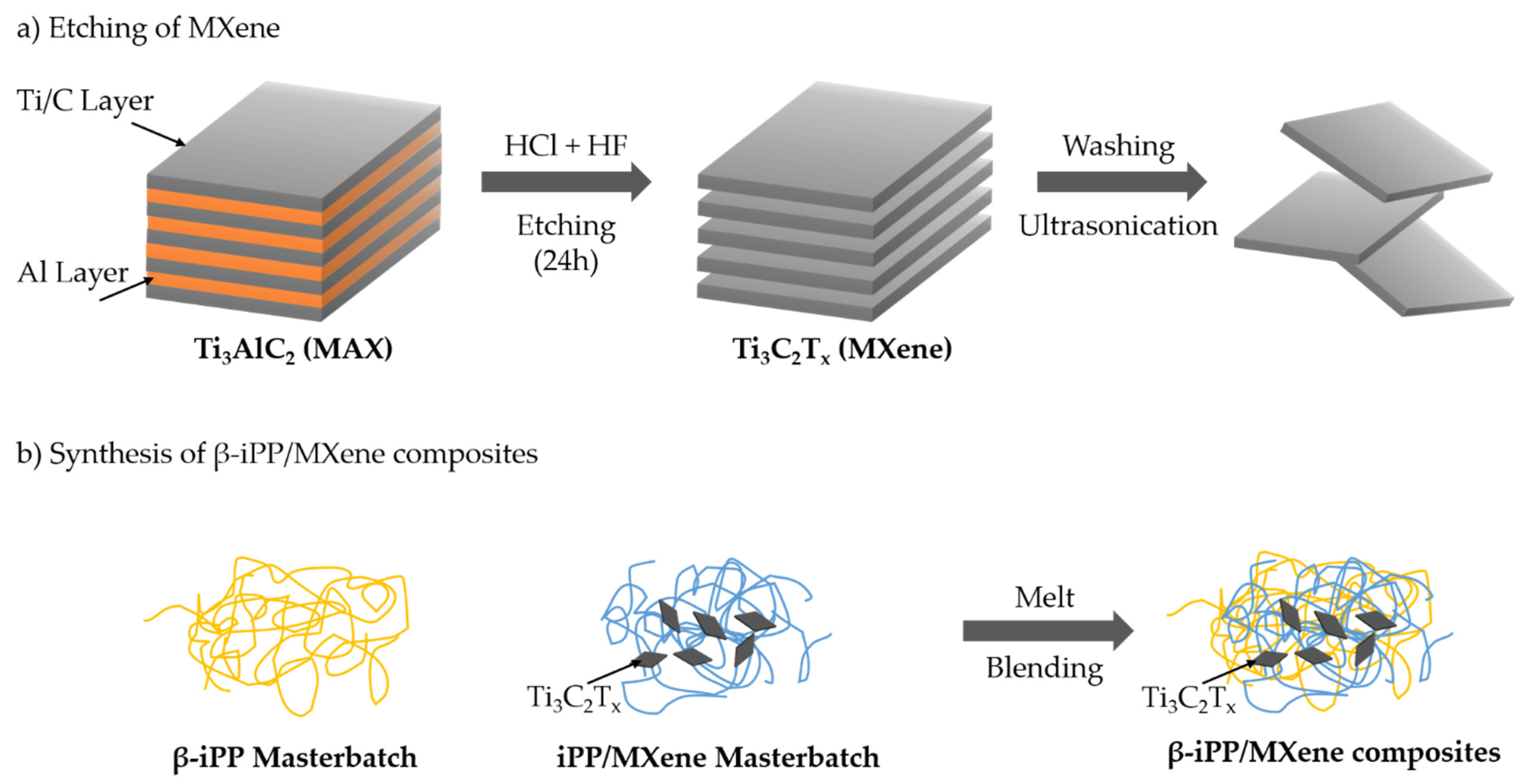

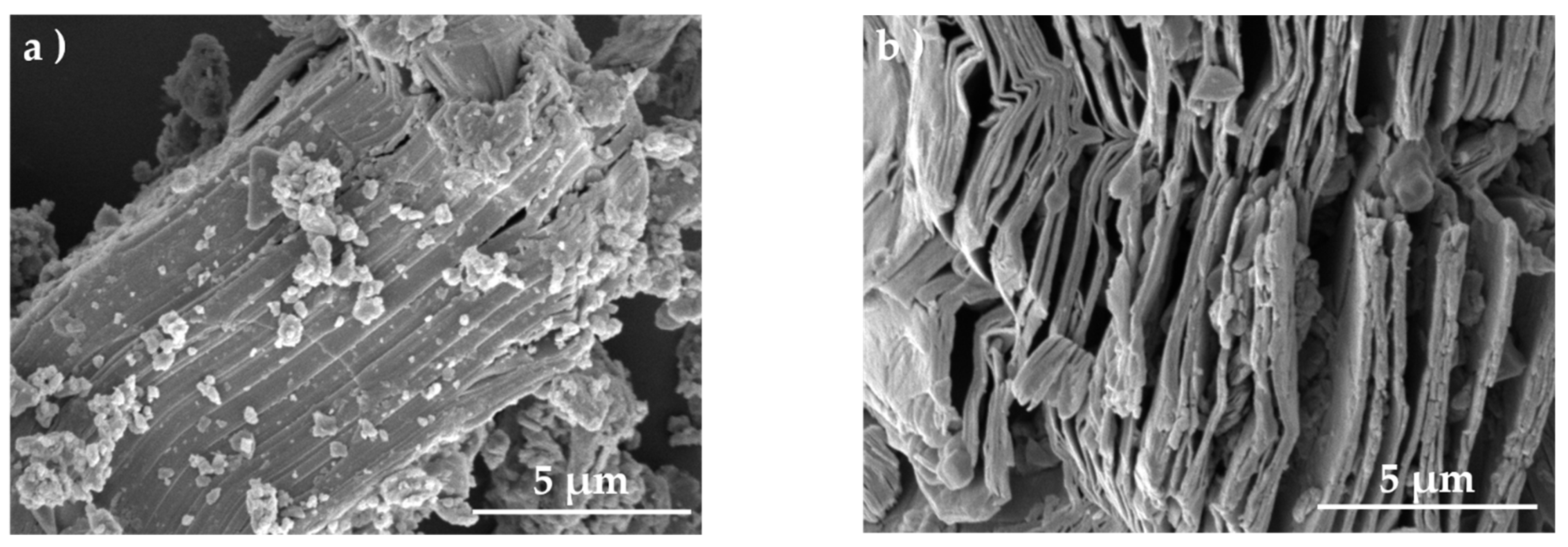
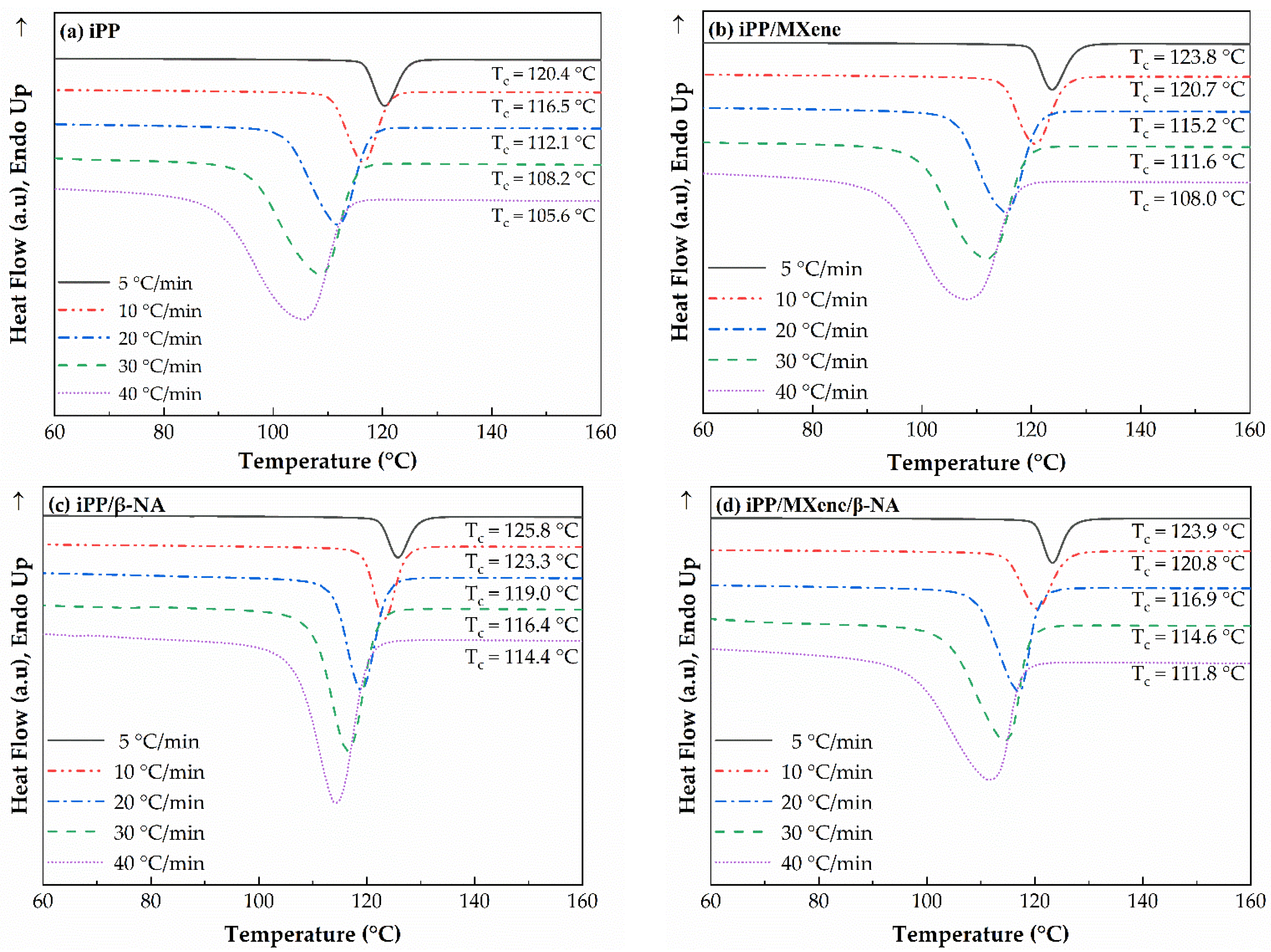
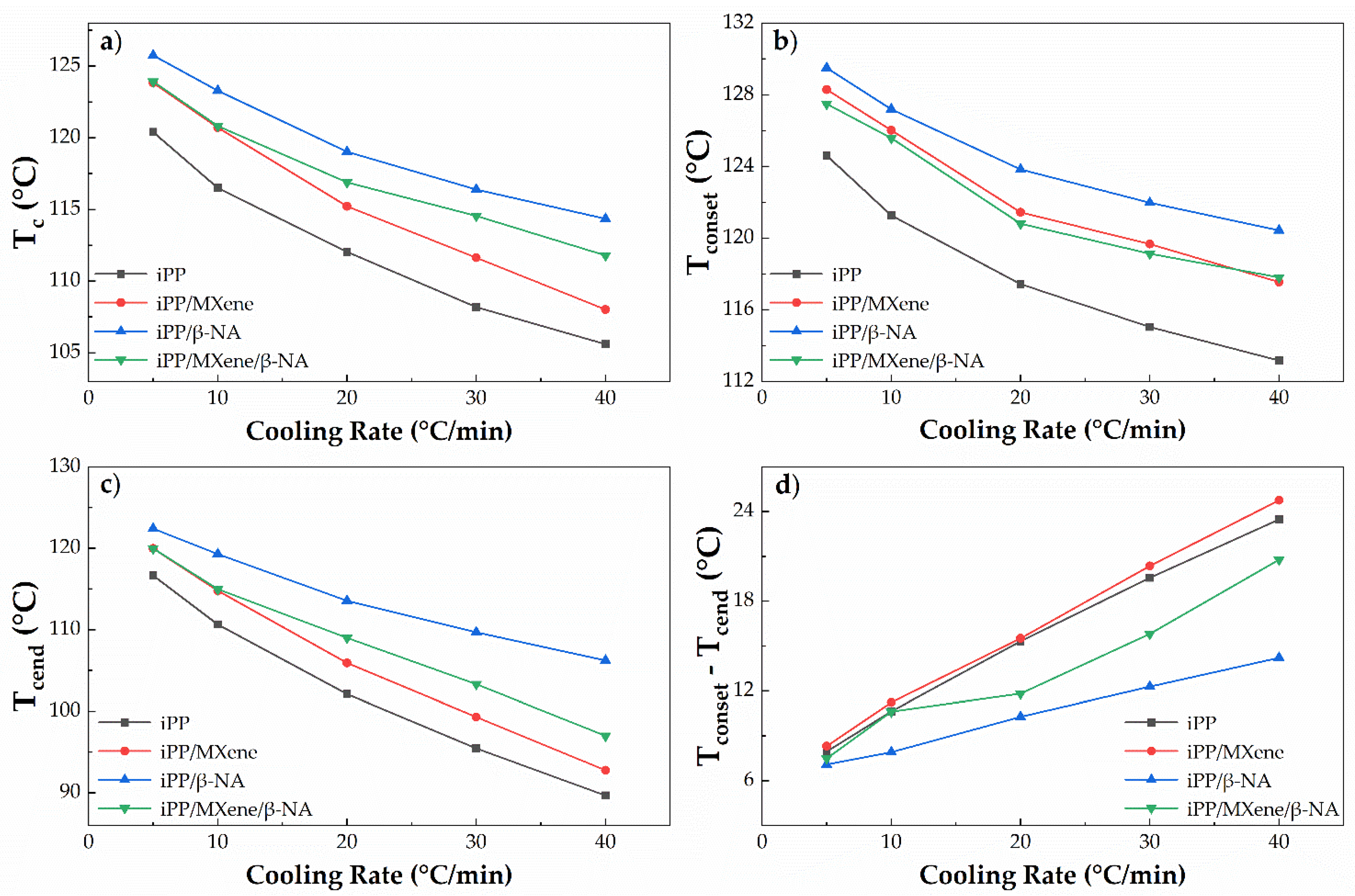
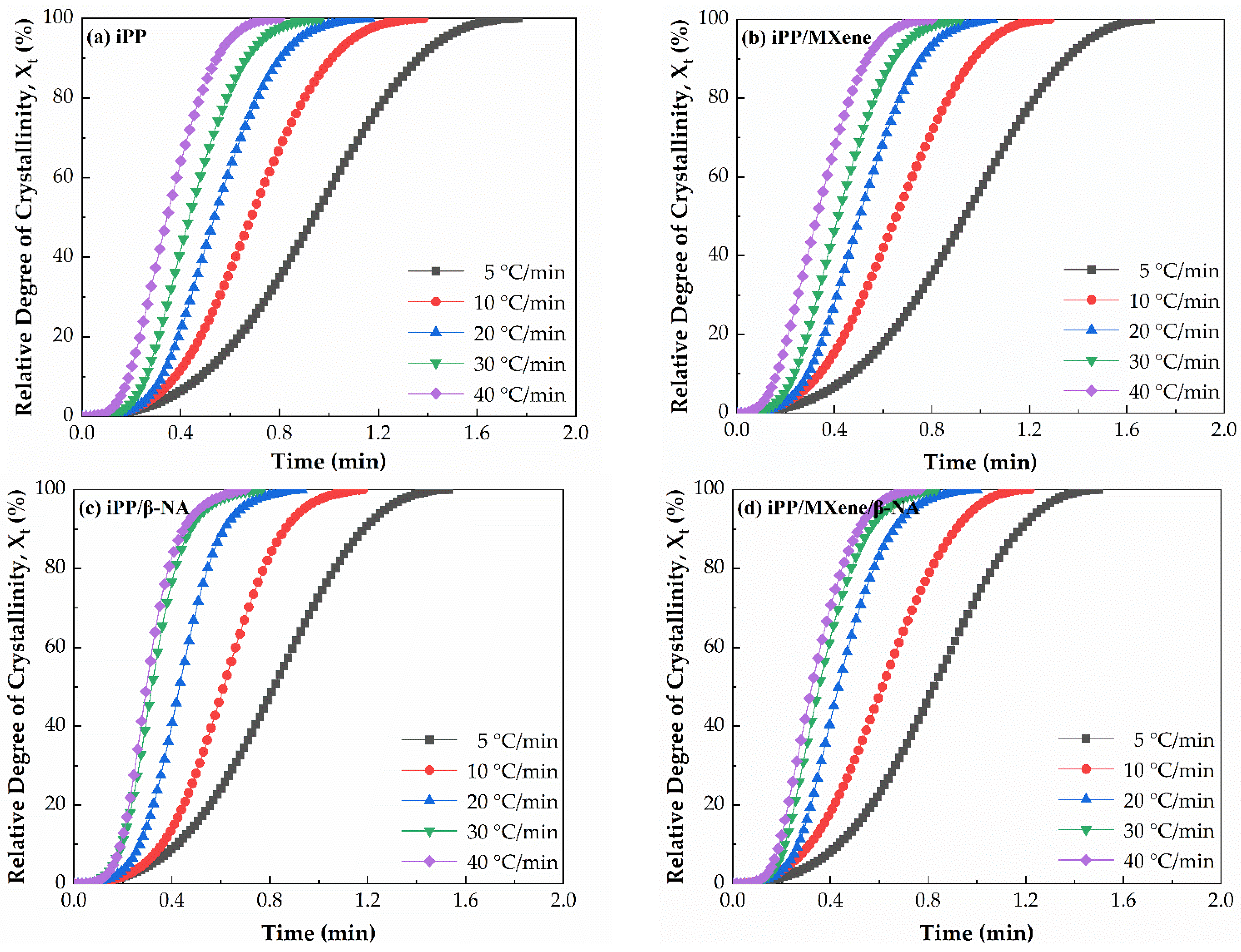
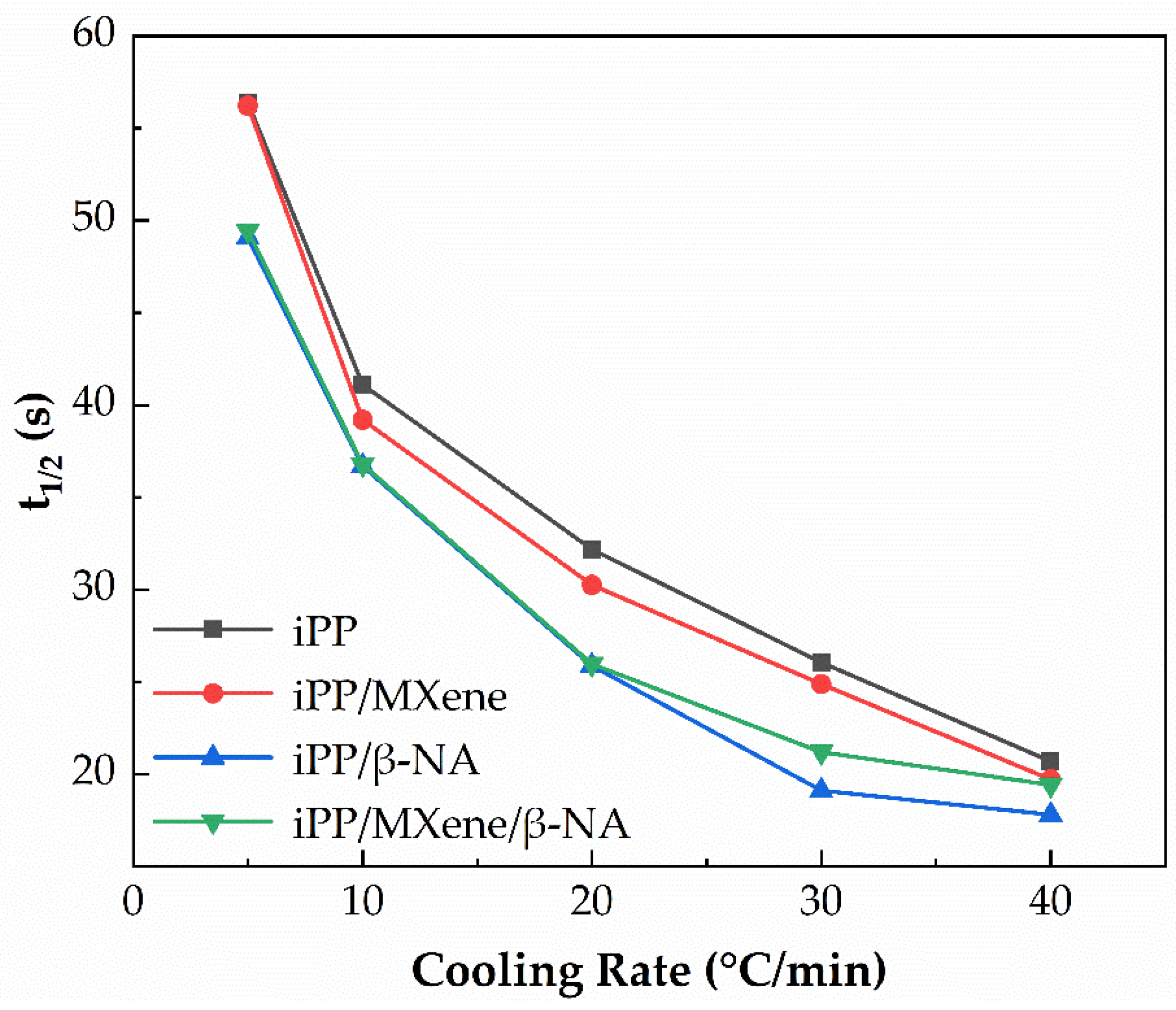

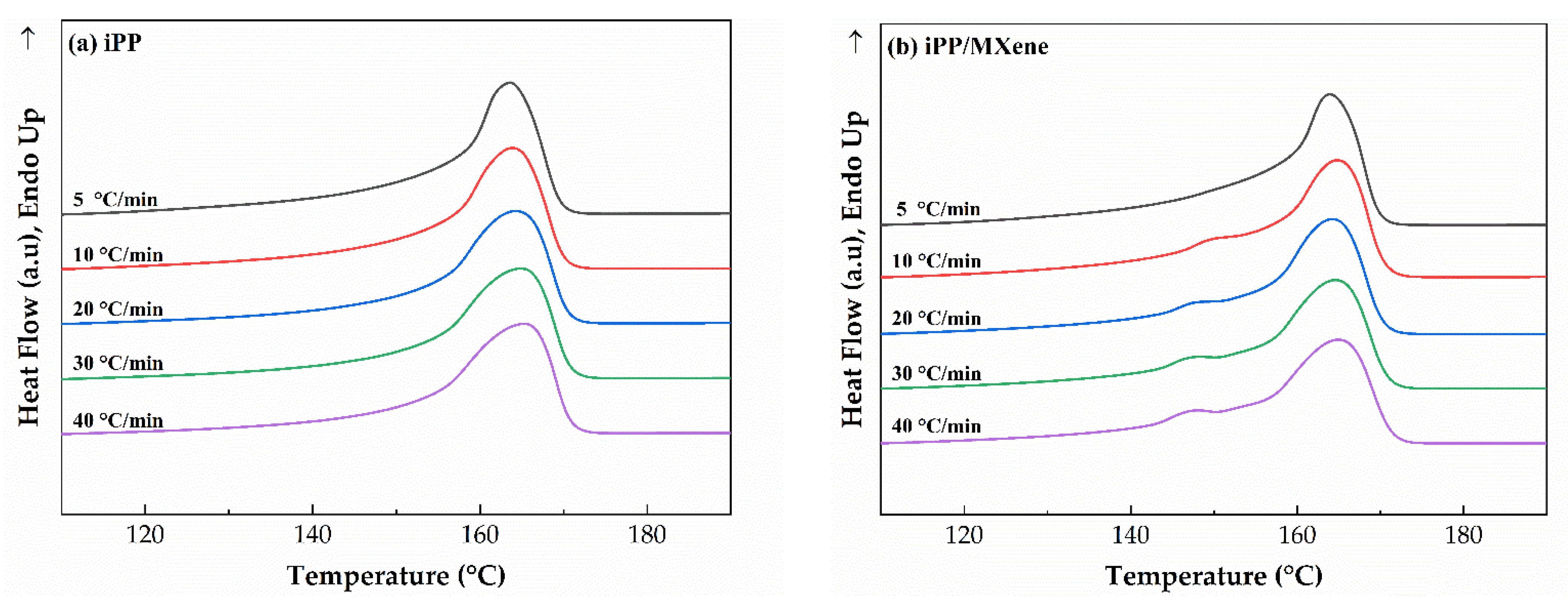





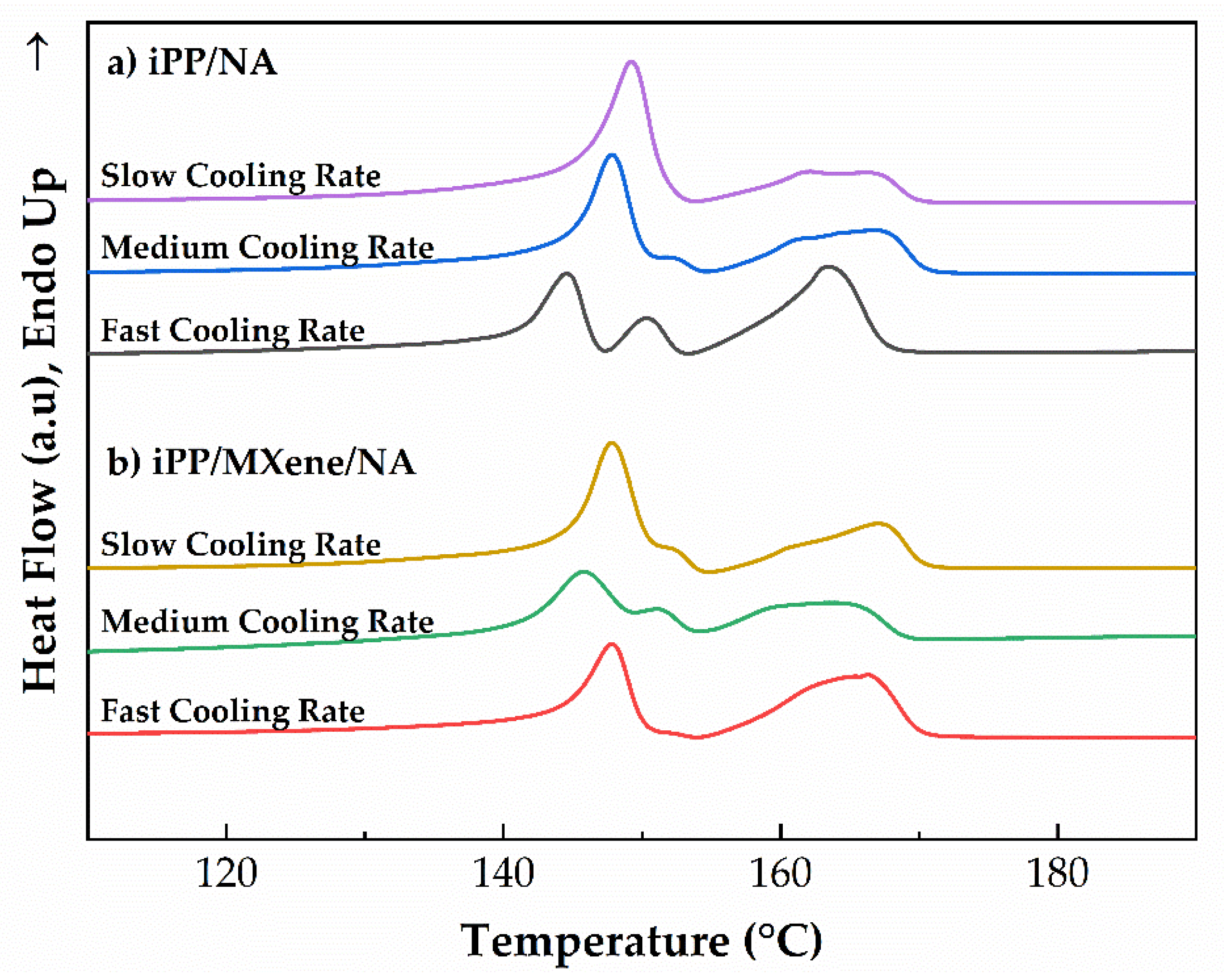

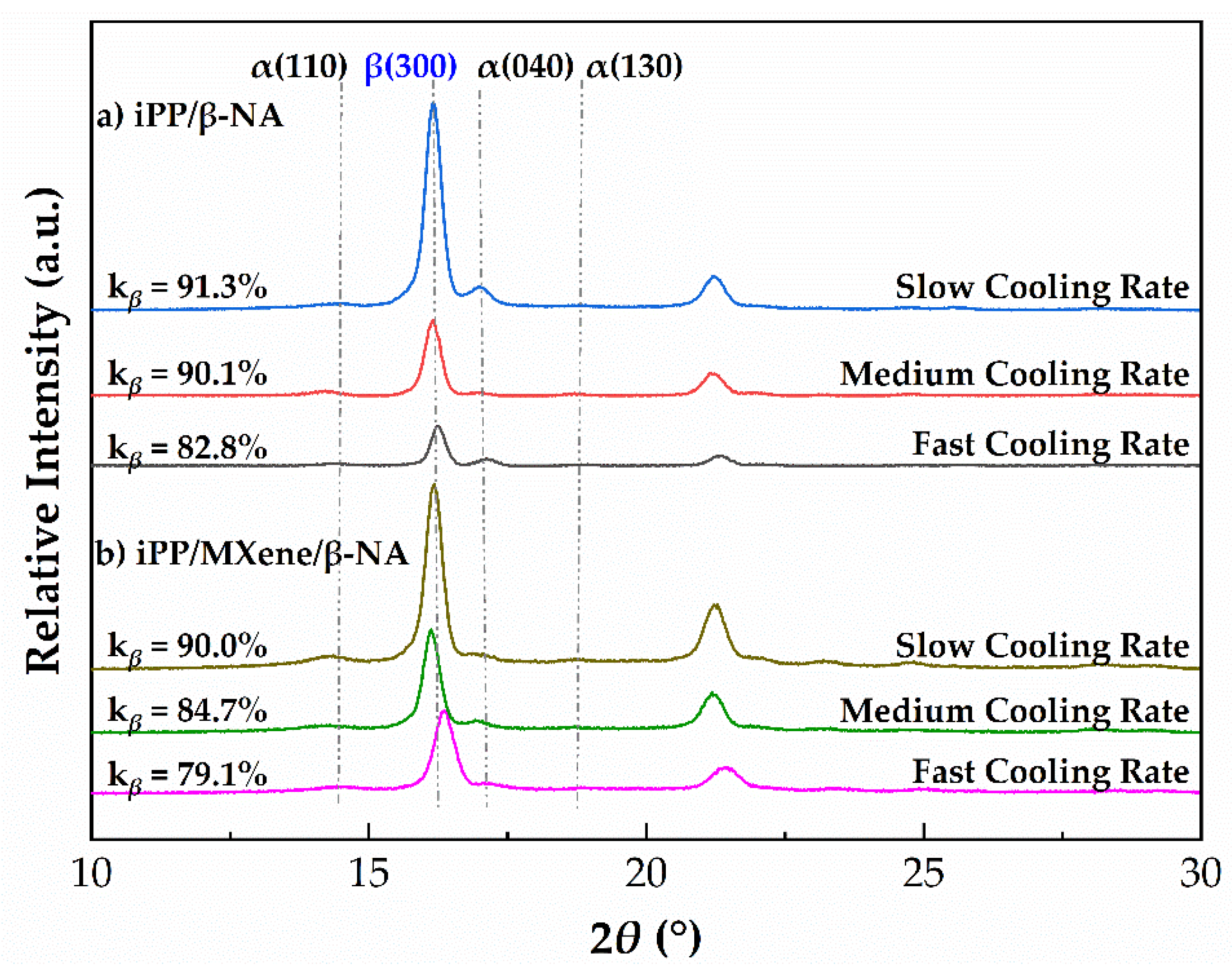
| Sample | Ec (kJ/mol) | Cooling Rate (°/min) | t1/2 (s) | N | lnk |
|---|---|---|---|---|---|
| iPP | −167.5 | 5 | 56.4 | 2.6 | −0.09 |
| 10 | 41.1 | 2.8 | 0.72 | ||
| 20 | 32.2 | 3.2 | 1.45 | ||
| 30 | 26.1 | 3.2 | 2.14 | ||
| 40 | 20.7 | 3.1 | 2.66 | ||
| iPP/MXene | −185.5 | 5 | 56.2 | 2.5 | −0.08 |
| 10 | 39.2 | 2.6 | 0.84 | ||
| 20 | 30.3 | 3.0 | 1.59 | ||
| 30 | 24.9 | 3.0 | 2.13 | ||
| 40 | 19.7 | 2.7 | 2.57 | ||
| iPP/β-NA | −233.8 | 5 | 49.1 | 2.6 | 0.27 |
| 10 | 36.7 | 2.9 | 1.07 | ||
| 20 | 25.9 | 3.1 | 2.12 | ||
| 30 | 19.1 | 3.1 | 2.86 | ||
| 40 | 17.8 | 3.3 | 3.25 | ||
| iPP/MXene/β-NA | −218.1 | 5 | 49.4 | 2.6 | 0.24 |
| 10 | 36.8 | 2.6 | 1.00 | ||
| 20 | 26.0 | 3.0 | 1.95 | ||
| 30 | 21.2 | 3.1 | 2.48 | ||
| 40 | 19.4 | 3.2 | 3.01 |
Publisher’s Note: MDPI stays neutral with regard to jurisdictional claims in published maps and institutional affiliations. |
© 2021 by the authors. Licensee MDPI, Basel, Switzerland. This article is an open access article distributed under the terms and conditions of the Creative Commons Attribution (CC BY) license (https://creativecommons.org/licenses/by/4.0/).
Share and Cite
Peng, W.; Sun, F.; Liang, Y.; Kang, J.; Chen, J.; Wang, W.; Cao, Y.; Xiang, M. Exploring the Effects of MXene on Nonisothermal Crystallization and Melting Behavior of β-Nucleated Isotactic Polypropylene. Polymers 2021, 13, 3815. https://doi.org/10.3390/polym13213815
Peng W, Sun F, Liang Y, Kang J, Chen J, Wang W, Cao Y, Xiang M. Exploring the Effects of MXene on Nonisothermal Crystallization and Melting Behavior of β-Nucleated Isotactic Polypropylene. Polymers. 2021; 13(21):3815. https://doi.org/10.3390/polym13213815
Chicago/Turabian StylePeng, Wanxin, Furui Sun, Yuke Liang, Jian Kang, Jinyao Chen, Wei Wang, Ya Cao, and Ming Xiang. 2021. "Exploring the Effects of MXene on Nonisothermal Crystallization and Melting Behavior of β-Nucleated Isotactic Polypropylene" Polymers 13, no. 21: 3815. https://doi.org/10.3390/polym13213815
APA StylePeng, W., Sun, F., Liang, Y., Kang, J., Chen, J., Wang, W., Cao, Y., & Xiang, M. (2021). Exploring the Effects of MXene on Nonisothermal Crystallization and Melting Behavior of β-Nucleated Isotactic Polypropylene. Polymers, 13(21), 3815. https://doi.org/10.3390/polym13213815








